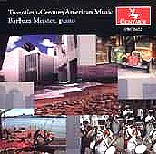Neither the CD jacket nor booklet notes tell us anything about pianist Barbara Meister, other than that she recorded this recital of 20th Century American piano music in 2002. The least known items hold the most interest. Paul Creston’s Six Preludes were set out to address issues of metrical subdivision and overlapping, yet didactic rigor takes a back seat to the music’s sunny neo-impressionist style. Meister’s relaxed virtuosity is quite different from Tatjana Rankovich’s taut, glittering approach (Phoenix). David Amram’s Three Movement sonata gathers gospel licks, wide-open-spaced modal portals, Ivesian bell tones, slow, wayward bass lines, Latin-influenced melodies, and blusey Coplandisms. The composer stirs these elements into a pot and comes up with a delicious, eclectic, and organically integrated musical stew. Amram himself passed a copy of the score to me in 1976, and I’m baffled that so few pianists have taken up its cause, for the work is audience-friendly and sounds more difficult than it actually is to play (I speak from experience!). Meister fares best in the music’s freer, more lyrical sections, but one needs a steadier basic pulse in the first movement for the jazz-inspired licks to make their best effect. And the third-movement variations require a more incisive touch and wider dynamic range than Meister offers.
In Copland’s Sonata, the pillar-like chords occupying register extremes lack Peter Lawson’s resonant solidity, while his crisply delineated middle movement is closer to Copland’s Vivace directive than Meister’s sedate point of view. She does a fine job with the Four Piano Blues, though. Meister softens the first Gershwin prelude’s infectious rumba beat and underplays the second prelude’s main tune while making too much of the left-hand chords. But don’t despair, because Meister musters up plenty of swing and decisiveness in the third prelude. Sonically speaking, this is one of the finest items I’ve heard out of Joseph Patrych’s sound studio.
































